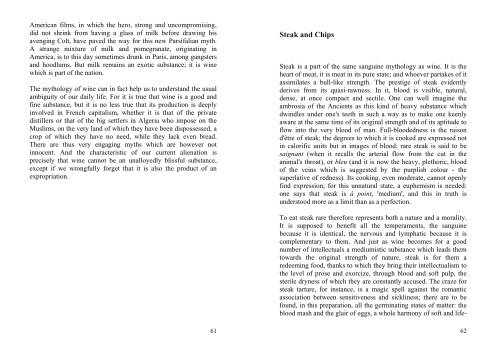Roland Barthes â Mythologies - soundenvironments
Roland Barthes â Mythologies - soundenvironments
Roland Barthes â Mythologies - soundenvironments
Create successful ePaper yourself
Turn your PDF publications into a flip-book with our unique Google optimized e-Paper software.
American films, in which the hero, strong and uncompromising,did not shrink from having a glass of milk before drawing hisavenging Colt, have paved the way for this new Parsifalian myth.A strange mixture of milk and pomegranate, originating inAmerica, is to this day sometimes drunk in Paris, among gangstersand hoodlums. But milk remains an exotic substance; it is winewhich is part of the nation.The mythology of wine can in fact help us to understand the usualambiguity of our daily life. For it is true that wine is a good andfine substance, but it is no less true that its production is deeplyinvolved in French capitalism, whether it is that of the privatedistillers or that of the big settlers in Algeria who impose on theMuslims, on the very land of which they have been dispossessed, acrop of which they have no need, while they lack even bread.There are thus very engaging myths which are however notinnocent. And the characteristic of our current alienation isprecisely that wine cannot be an unalloyedly blissful substance,except if we wrongfully forget that it is also the product of anexpropriation.Steak and ChipsSteak is a part of the same sanguine mythology as wine. It is theheart of meat, it is meat in its pure state; and whoever partakes of itassimilates a bull-like strength. The prestige of steak evidentlyderives from its quasi-rawness. In it, blood is visible, natural,dense, at once compact and sectile. One can well imagine theambrosia of the Ancients as this kind of heavy substance whichdwindles under one's teeth in such a way as to make one keenlyaware at the same time of its original strength and of its aptitude toflow into the very blood of man. Full-bloodedness is the raisond'être of steak; the degrees to which it is cooked are expressed notin calorific units but in images of blood; rare steak is said to besaignant (when it recalls the arterial flow from the cut in theanimal's throat), or bleu (and it is now the heavy, plethoric, bloodof the veins which is suggested by the purplish colour - thesuperlative of redness). Its cooking, even moderate, cannot openlyfind expression; for this unnatural state, a euphemism is needed:one says that steak is à point, 'medium', and this in truth isunderstood more as a limit than as a perfection.To eat steak rare therefore represents both a nature and a morality.It is supposed to benefit all the temperaments, the sanguinebecause it is identical, the nervous and lymphatic because it iscomplementary to them. And just as wine becomes for a goodnumber of intellectuals a mediumistic substance which leads themtowards the original strength of nature, steak is for them aredeeming food, thanks to which they bring their intellectualism tothe level of prose and exorcize, through blood and soft pulp, thesterile dryness of which they are constantly accused. The craze forsteak tartare, for instance, is a magic spell against the romanticassociation between sensitiveness and sickliness; there are to befound, in this preparation, all the germinating states of matter: theblood mash and the glair of eggs, a whole harmony of soft and life-6162




